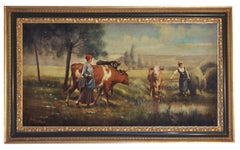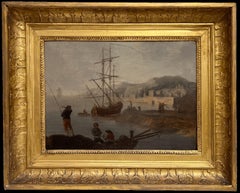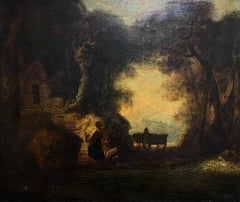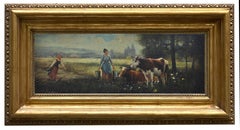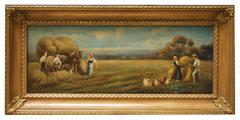Emilio Pergola Art
to
1
1
3
Overall Width
to
Overall Height
to
5
1
5
5
2
2
2
1
1
1
1
1
1
1
1
5
5
5
5
5
8,234
2,807
1,648
1,318
4
3
5
Artist: Emilio Pergola
COUNTRY LANDSCAPE - Italian School - Italian Oil on Canvas Painting
By Emilio Pergola
Located in Napoli, IT
Country Landscape - Emilio Pergola Italia 2005 - Oil on canvas cm.80x120.
Gold leaf gilded wooden frame available on request
This oil on canvas painting depicts a pastoral scene. T...
Category
Early 2000s Old Masters Emilio Pergola Art
Materials
Canvas, Oil
COUNTRY SCENE- French School - Italian Oil on Canvas Painting
By Emilio Pergola
Located in Napoli, IT
Country Scene - Emilio Pergola Italia 2006 - Oil on canvas cm.50x130
The painting by E. Pergola is a painting inspired by the rural realism works of Julien Dupré French painter. Dupret was one of the main exponents of French realism...
Category
Early 2000s French School Emilio Pergola Art
Materials
Canvas, Oil
COUNTRY LANDSCAPE - Emilio Pergola - Italian Oil on Canvas Painting
By Emilio Pergola
Located in Napoli, IT
Country landscape - Emilio Pergola Italia 2006 - Oil on canvas cm.40x80.
The painting by E. Pergola is a painting inspired by the rural realism works of Julien Dupré French painter. Dupret was one of the main exponents of French realism, an accurate observer of the landscape and of the life of peasants in the countryside. The painting depicts a scene in the fields where some women milk the milk from a goat, others work on the hay bales. The creative technique of Pergola is a touch of art, his rural landscapes, the cottege, his beloved animals such as horses and cows...
Category
Early 2000s French School Emilio Pergola Art
Materials
Canvas, Oil
COUNTRY LANDSCAPE - French School - Italian Oil on Canvas Painting
By Emilio Pergola
Located in Napoli, IT
Country landscape - Emilio Pergola Italia 2006 - Oil on canvas cm.50x130
Pergola's works reveal the touch of antiquity that recalls the past where shapes and colors are happily combined.
A well-harmonized painting that draws inspiration from the paintings of the French master Leon Augustin Lhermitte.
Lhermitte preferred to portray rural scenes and the peasants at work, so much so that he was called "the painter of the reapers".
In this beautiful oil on canvas we admire some scenes of life in the fields, some women work while others prepare their lunch.
In each painting, Pergola observes the world with deep care, outlining the most important values, the essence and the cosmic symbolism of nature. Pergola's creative technique is a touch of art, its rural landscapes, cottages, its beloved animals, such as horses and cows...
Category
Early 2000s French School Emilio Pergola Art
Materials
Canvas, Oil
COUNTRY LANDSCAPE - French School -Italian Oil on Canvas Painting
By Emilio Pergola
Located in Napoli, IT
Country Landscape - Emilio Pergola Italia 2005 - Oil on canvas cm.50x100.
Pergola’s works reveal that touch of antiquity that recalls the past. A well-harmonized painting that draws inspiration from the paintings of the French master Leon Augustin Lhermitte. Lhermitte preferred to portray rural scenes and peasants at work, so much so that he was called “the painter of the reapers”. In this beautiful oil on canvas we admire some scenes of life in the fields, a woman works in the fields, another woman carries freshly milked milk. The creative technique of Pergola is a touch of art, its rural landscapes, the cottege, his beloved animals, such as horses and cows...
Category
Early 2000s French School Emilio Pergola Art
Materials
Canvas, Oil
Related Items
18th Century French Old Master Oil Painting Ancient Port Harbor Shipping Marine
Located in Cirencester, Gloucestershire
Harbor Scene
Circle of Claude Joseph Vernet (French, 1714-1789)
oil painting on canvas, framed in antique gilt frame
framed: 20.5 x 25.5
canvas: 19 x 23.5 inches
condition: very good...
Category
18th Century Old Masters Emilio Pergola Art
Materials
Oil, Canvas
$2,871 Sale Price
30% Off
H 20.5 in W 25.5 in
Large 18th Century British Old Master Oil Painting Figures at Dusk in Woodland
Located in Cirencester, Gloucestershire
The Close of Day
English artist, second half 18th century
circle of Thomas Gainsborough (British 1727-1788)
oil on canvas, unframed
canvas: 24.5 x 29 inches
provenance: private colle...
Category
18th Century Old Masters Emilio Pergola Art
Materials
Oil, Canvas
$2,140 Sale Price
30% Off
H 24.5 in W 29 in
Shipping in Stormy Waters, Attributed to Italian Artist Francesco Guardi
By Francesco Guardi
Located in Stockholm, SE
The splendour of the tragic sea
Francesco Guardi and maritime painting in Venetian art
No Venetian painter was a stranger to the sea. After all, Venice was not only one of the most prominent ports of the Mediterranean, but indeed a city literally submerged in the ocean from time to time. Curiously however, the famous Venetian school of painting showed little interest in maritime motifs, favouring scenes from the iconic architecture of the city rather than seascapes. That is why this painting is a particularly interesting window into not only the painter Francesco Guardi himself – but to the significance of the element of water in art history, in absence as well as in the centre of attention.
Whether it be calm, sunny days with stunning views of the palaces alongside the canals of Venice or – more rarely – stormy shipwrecking tragedies at sea, water as a unifying element is integral to the works of painter Francesco Guardi (1712–1793). During his lifetime, Venetian art saw many of its greatest triumphs with names like Tiepolo or Canaletto gaining international recognition and firmly establishing Venice as one of the most vibrant artistic communities of Europe. While the city itself already in the 18th century was something of an early tourist spot where aristocrats and high society visited on their grand tour or travels, the artists too contributed to the fame and their work spread the image of Venice as the city of romance and leisure to an international audience, many of whom could never visit in person.
Still today, the iconic image of Venice with its whimsical array of palaces, churches and other historic buildings is much influenced by these artists, many of whom have stood the test of time like very well and remain some of the most beloved in all of art history. It was not primarily subtility, intellectual meanings or moral ideals that the Venetian art tried to capture; instead it was the sheer vibrancy of life and the fast-paced city with crumbling palaces and festive people that made this atmosphere so special. Of course, Venice could count painters in most genres among its residents, from portraiture to religious motifs, history painting and much else. Still, it is the Vedutas and views of the city that seems to have etched itself into our memory more than anything else, not least in the tradition of Canaletto who was perhaps the undisputed master of all Venetian painters.
Born into his profession, Francesco lived and breathed painting all his life. His father, the painter Domenico Guardi (1678–1716) died when Francesco was just a small child, yet both he and his brothers Niccolò and Gian Antonio continued in their fathers’ footsteps. The Guardi family belonged to the nobility and originated from the mountainous area of Trentino, not far from the Alps. The brothers worked together on more challenging commissions and supported each other in the manner typical of family workshops or networks of artists. Their sister Maria Cecilia married no other than the artist Giovanni Battista Tiepolo himself, linking the family to the most renowned Venetian name of the time. During almost a decade, Guardi worked in the studio of Michele Giovanni Marieschi, sometimes simply known as Michiel, a painted similar in both style and motif. Canaletto is, however, the artist Guardi is most often compared to since they shared a mutual fascination for depicting the architecture and cityscape of Venice.
During the course of his career, Guardi tried his hand in many different genres. He was as swift in painting landscapes, Vedutas of Venice, sacred motifs, interiors and architectural compositions as he was in a number of other motifs. His style is typical of the Venetian school but also distinct and personal once we look a little closer. There is an absolute certainty in the composition, the choice of which sometimes feels like that of a carefully calculated photograph – yet it is also very painterly, in the best sense of the word: fluid, bold, sensitive and full of character. The brushwork is rapid, intense, seemingly careless and extraordinarily minute at the same time; fresh and planned in a very enjoyable mixture. His interiors often capture the breath-taking spacious glamour of the palaces and all their exquisite decor. He usually constructed the motif through remarkably simple, almost spontaneous yet intuitively precise strokes and shapes. The result was a festive, high-spirited atmospheric quality, far away from the sterile and exact likeness that other painters fell victim to when trying to copy Canaletto.
The painting here has nothing of the city of Venice in it. On the contrary, we seem to be transported far away into the solitary ocean, with no architecture, nothing to hold on to – only the roaring sea and the dangerous cliffs upon which the ships are just moments away from being crushed upon. It is a maritime composition evoking both Flemish and Italian precursors, in the proud tradition of maritime painting that for centuries formed a crucial part of our visual culture.
This genre of painting is today curiously overlooked, compared to how esteemed and meaningful it was when our relationship to the sea was far more natural than it is today. When both people and goods travelled by water, and many nations and cities – Venice among them – depended entirely on sea fare, the existential connection to the ocean was much more natural and integrated into the imagination. The schools and traditions of maritime art are as manifold as there are countries connected to the sea, and all reflect the need to process the dangers and wonders of the ocean.
It could symbolize opportunity, the exciting prospects of a new countries and adventures, prospering trade, beautiful scenery as well as war and tragedy, loss of life, danger and doom. To say that water is ambivalent in nature is an understatement, and these many layers were something that artists explored in the most wondrous ways. Perhaps it takes a bit more time for the modern eye to identify the different nuances and qualities of historic maritime paintings, they may on first impression seem hard to differentiate from each other. But when allowing these motifs to unfold and tell stories of the sea in both fiction and reality – or somewhere in between – we are awarded with an understanding of how the oceans truly built our world.
In Guardi’s interpretation, we see an almost theatrically arranged shipwrecking scene. No less than five ships are depicted right in the moment of utter disaster. Caught in a violent storm, the waves have driven them to a shore of sharp cliffs and if not swallowed by the waves, crushing against the cliffs seems to be the only outcome. The large wooden ships are impressively decorated with elaborate sculpture, and in fact relics already during Guardi’s lifetime. They are in fact typical of Dutch and Flemish 17th century ships, giving us a clue to where he got the inspiration from. Guardi must have seen examples of Flemish maritime art, that made him curious about these particular motifs. One is reminded of Flemish painters like Willem van de Velde and Ludolf Backhuysen, and this very painting has indeed been mistakenly attributed to Matthieu van Plattenberg...
Category
18th Century Old Masters Emilio Pergola Art
Materials
Canvas, Oil
$47,899 Sale Price
32% Off
H 25.79 in W 29.14 in
Shepherd with Sheep, Cows and a Goat in a Landscape by Jan Frans Soolmaker
Located in Stockholm, SE
This painting depicts a pastoral scene that is attributed to the artist Jan Frans Soolmaker, an artist known for his Italianate landscapes and scenes that often feature equestrian and Arcadian elements. The painting is not signed but is attributed to Soolmaker, relating it to a known signed work by the artist that was sold at Sotheby’s London in 1999.
The scene is suffused with the warm glow of a setting or rising sun, casting a soft light that is characteristic of Soolmaker’s landscapes. It shows a shepherd guiding a group of cattle across a shallow stream, with the animals taking center stage in the composition. The animals are rendered with careful attention to their forms and the play of light on their bodies, which is a hallmark of Soolmaker's work. The landscape is composed of a rocky terrain with trees and shrubbery, creating a sense of depth and natural beauty that invites the viewer to explore the scene further.
The background suggests a vast, open landscape with distant mountains, which adds to the Italianate feel of the painting. The sky is dramatic, with clouds catching the light of the sun, contributing to the overall serene yet dynamic atmosphere of the work.
The provenance of the painting is notable, having been in the possession of significant historical figures such as Swedish Prince Fredrik Adolf, and later The collection of Pär Ulmgren, The collection of Gösta Stenman, and Engineer and politician Gustaf Henry Hansson.
Potential buyers have the option of choosing between a newly made gold frame or an older brown frame, which allows for personalization in how the work is presented.
Soolmaker’s work is often compared to that of Dutch painter Nicolaes Berchem, whose style he emulated. Soolmaker's landscapes reflect a similar sensitivity to light and composition, making his works sought after for their beauty and historical significance. Despite the smaller body of work left by Soolmaker, due to his short career, his paintings are valued for their craftsmanship and the legacy of the artist’s brief but impactful contribution to the Dutch Italianate landscape genre.
Information:
Jan Frans Soolmaker (Flanders 1635‑1685)
Shepherd with Sheep...
Category
17th Century Old Masters Emilio Pergola Art
Materials
Canvas, Oil
$4,321 Sale Price
20% Off
H 22.05 in W 20.87 in
Landscape Near Felday, Surrey
By Abraham Hulk the Younger
Located in Hillsborough, NC
Dutch/English artist Abraham Hulk the Younger (1851-1922) is most known for landscapes of the British countryside. This work is one of a pair (the second work is also available by s...
Category
Late 19th Century Old Masters Emilio Pergola Art
Materials
Canvas, Oil
$2,240 Sale Price
20% Off
H 27 in W 22.75 in D 2.13 in
Huge 19th Century Italian Classical Still Life Ornamental Birds Fruit & Flowers
Located in Cirencester, Gloucestershire
Ornamental Still Life with fruit, flowers and birds
Italian School, 19th century
oil painting on canvas, unframed
size: 31.5 x 47 inches
condition: relined canvas and in very good and presentable condition
provenance: from a collection here in England.
A very beautiful and decorative oil painting on a huge scale, depicting this classical landscape scene, with ornamental birds...
Category
19th Century Old Masters Emilio Pergola Art
Materials
Canvas, Oil
$3,211 Sale Price
30% Off
H 31.5 in W 47 in D 1 in
Mid 17th Century British Old Master Oil Painting Portrait of Man in Flemish City
Located in Cirencester, Gloucestershire
Portrait of Thomas Collard (rector of Withycombe, Somerset 1670-1691)
the city depicted in the distance is thought to be Antwerp.
the portrait historically has been thought to be fr...
Category
Mid-17th Century Old Masters Emilio Pergola Art
Materials
Oil, Canvas
$3,163 Sale Price
30% Off
H 30 in W 25 in
Military Camp Scene and Battle. Pietro Graziani (XVII/XVIII century), entourage
Located in Firenze, IT
Military Camp Scene and Battle.
Pietro Graziani (XVII/XVIII century), entourage.
A pair ( two) of small paintings.
Antique XIX century frames in gilt wood.
In good condition.
Oi...
Category
Early 18th Century Old Masters Emilio Pergola Art
Materials
Canvas, Oil
$2,500 Sale Price
40% Off
H 13.39 in W 10.24 in D 1.19 in
A Soldier Blowing the Trumpet by French Artist Charles Bouchez, Oil on Canvas
Located in Stockholm, SE
Charles Bouchez (1811-1882) French
A Soldier Blowing the Trumpet
oil on canvas
signed and dated ch. Bouchez 1842
canvas dimensions 6.29 x 4.13 inches (16 x 10.5 cm)
frame 10.23 x 7...
Category
1840s French School Emilio Pergola Art
Materials
Canvas, Oil
$2,108 Sale Price
20% Off
H 10.24 in W 7.88 in
French School Honfleur Mid 20th Century Oil Painting
By Frank Myers Boggs
Located in Holywell, GB
French School Honfleur Follower of Frank Myers BOGGS (1855-1926)
A pleasing harbour scene depicting Honfleur in Northern France. Painted in an impressionistic style with great spontaneity using the dark brooding colour palette reminiscent of the work of Frank Boggs. Honfleur was the centre of a small artist’s colony during the late 19th and 20th centuries. Boggs concentrated on painting marine...
Category
Mid-20th Century French School Emilio Pergola Art
Materials
Canvas, Oil
Antique French School Marine Ship Fishing Boats Oil Canvas Painting Dieppe 1851
Located in Portland, OR
A very attractive mid 19th century marine oil painting, by the celebrated French artist Charles Hoguet (1821-1870), Dieppe 1851.
The painting depicts three masted fishing boats with ...
Category
1850s French School Emilio Pergola Art
Materials
Canvas, Oil
$6,995
H 31.5 in W 25 in D 3.25 in
Fine 18th Century Italian Old Master Oil Painting Berghers with Animals Sunset
Located in Cirencester, Gloucestershire
The Close of Day
Italian School, early 18th century
oil on canvas, unframed
canvas: 17 x 22.5 inches
provenance: private collection, France
condition: very good and sound condition
Category
18th Century Old Masters Emilio Pergola Art
Materials
Oil, Canvas
Previously Available Items
COUNTRY SCENE - French School - Italian - Figurative - Oil on canvas painting
By Emilio Pergola
Located in Napoli, IT
Country scene - Emilio Pergola Italia 2004 - Oil on canvas cm. 20x55.
Pergola’s works reveal that touch of antiquity that recalls the past. A well-harmonized painting that draws inspiration from the paintings of the French master Leon Augustin Lhermitte. Lhermitte preferred to portray rural scenes and peasants at work, so much so that he was called “the painter of the reapers”. In this beautiful oil on canvas we admire some scenes of life in the fields, a woman works in the fields, another woman carries freshly milked milk. The creative technique of Pergola is a touch of art, its rural landscapes, the cottege, his beloved animals, such as horses and cows...
Category
Early 2000s French School Emilio Pergola Art
Materials
Canvas, Oil
COUNTRY SCENE
By Emilio Pergola
Located in Napoli, IT
Country scene - Emilio Pergola Italia 2003 - Oil on canvas cm.30 x 80.
Category
Early 2000s Old Masters Emilio Pergola Art
Materials
Canvas, Oil
Emilio Pergola art for sale on 1stDibs.
Find a wide variety of authentic Emilio Pergola art available for sale on 1stDibs. You can also browse by medium to find art by Emilio Pergola in canvas, fabric, oil paint and more. Much of the original work by this artist or collective was created during the 21st century and contemporary and is mostly associated with the Old Masters style. Not every interior allows for large Emilio Pergola art, so small editions measuring 22 inches across are available. Customers who are interested in this artist might also find the work of Giovanni Santaniello, Achille-Émile Othon Friesz, and Guy Bardone. Emilio Pergola art prices can differ depending upon medium, time period and other attributes. On 1stDibs, the price for these items starts at $1,318 and tops out at $3,953, while the average work can sell for $3,569.
Artists Similar to Emilio Pergola
Questions About Emilio Pergola Art
- 1stDibs ExpertNovember 20, 2024The difference between a pergola and a pagoda is design. A pergola is a structure with an open design consisting of pillars supporting a retractable roof or a removable fabric canopy. Derived from Asian architecture, a pagoda has a tower-like shape and a permanent pointed roof. On 1stDibs, find a range of pergolas and pagodas.



